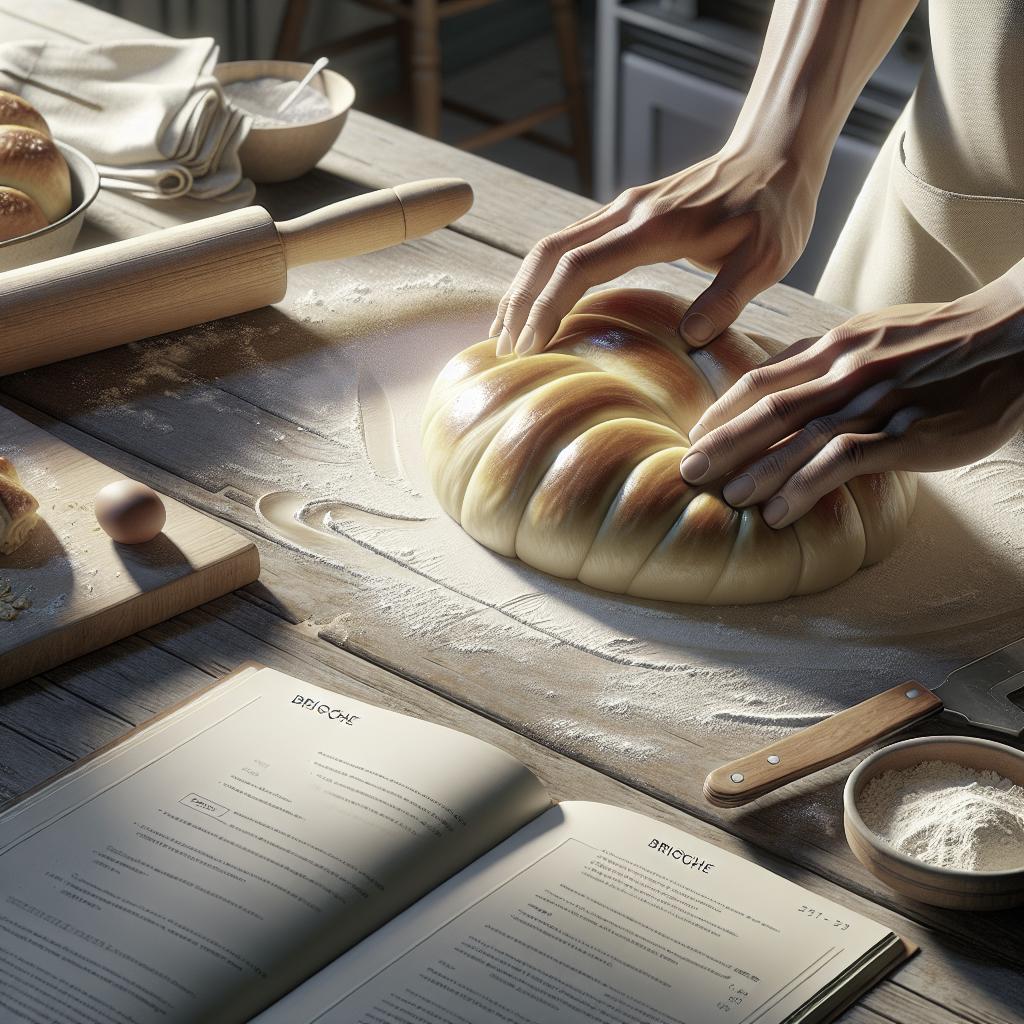<>
Brioche, with its golden-brown crust and lush, buttery interior, can seem intimidating to bake. However, this detailed guide will walk you through every step of crafting a perfect brioche loaf by hand. From gathering ingredients to mastering the windowpane test, you’ve got all the information you need here. Whether you’re a seasoned baker or a novice, our practical advice and tips will ensure your brioche turns out beautifully soft and delicious every time.
About This Recipe
This recipe is designed for those who appreciate the art of baking and wish to delve into making brioche from scratch. Our step-by-step guide will take you through artisanal-level tips and techniques to ensure a successful outcome. You will also learn, through hands-on practice, why brioche is revered for its rich texture and subtle sweetness.
In this journey, we’ll cover everything from ingredient selection to the nuances of kneading, rising, and baking. You’ll gain confidence in shaping the delicate dough by hand, ensuring each loaf showcases that quintessential lightness only found in properly made brioche.
Ingredient Notes
Quality ingredients are key to achieving the best results. Use high-protein bread flour for a strong dough structure, which will help develop the gluten needed for the loaf’s characteristic airy texture. Butter, a vital component, should be unsalted and at room temperature to incorporate seamlessly into the dough.
Eggs add richness and color to the brioche. Use them at room temperature to ensure they mix well. Sugar provides a touch of sweetness and acts as food for the yeast, necessary for fermentation. Lastly, use whole milk to further enhance the dough’s tenderness.
🍽 Mise en place (aka “the setup”)
Before you begin, gather all your ingredients and equipment. “Mise en place,” a French culinary term meaning “everything in its place,” is crucial for an organized, stress-free baking experience. Pre-measure your ingredients, ensuring each one is at the correct temperature.
Have your stand mixer fitted with a dough hook ready. Additionally, prepare a clean surface for kneading and a lightly greased bowl for the dough’s first rise. This preparation step will streamline your process and keep your workspace orderly.
How to Make Brioche Bread Dough
Start by blooming your yeast in warm milk with a pinch of sugar until foamy. This step activates the yeast, ensuring it will leaven the dough properly. Next, add the milk and yeast mixture to your flour and mix until just combined. Let it rest for 10 minutes to hydrate the flour.
Gradually add eggs and softened butter, mixing until each addition is fully incorporated. Knead the dough on medium speed for about 10 minutes, or until it pulls away from the sides of the bowl and is smooth and elastic. The dough will be soft and slightly sticky due to the high butter content.
Passing the Windowpane Test
To ensure your dough has developed enough gluten, perform the windowpane test. Take a small piece of dough and stretch it between your fingers. If it forms a thin, translucent membrane without tearing, your dough is ready.
If the dough tears easily, continue kneading for a few more minutes and test again. This step is crucial in achieving the airy, fluffy texture that brioche is known for.
The First Rise (Bulk Fermentation)
Place the dough in a lightly greased bowl, cover it with plastic wrap or a damp cloth, and let it rise at room temperature until doubled in size, approximately 1.5 to 2 hours.
This fermentation period allows the yeast to produce carbon dioxide, which will give the brioche its light and airy quality. The rise time may vary depending on the ambient temperature of your kitchen.
Shaping A Brioche Loaf
Once the dough has doubled, gently deflate it by pressing down with your fingers. Transfer the dough to a lightly floured surface. For a standard loaf, shape the dough into a rectangle, then fold one third over the center, then the other third over that (like folding a letter).
Gently roll the folded dough into a log shape that fits your loaf pan. Place it seam-side down into a lightly greased loaf pan. For a traditional brioche à tête, shape smaller pieces of dough and place them in the loaf pan, giving it a distinctive appearance.
The Second Brioche Rise
After shaping, cover the dough lightly with plastic wrap or a kitchen towel and let it rise until doubled in size again, which should take about 1 hour. This second rise ensures that the dough will have a fine, tender crumb.
Pay close attention during this stage; over-proofing can cause the bread to deflate during baking. The dough is ready when it springs back slowly to the touch but still retains a slight indentation.
Baking Brioche
Preheat your oven to 375°F (190°C). Before baking, you can give the dough an egg wash made of one beaten egg with a splash of water. This will give the brioche its characteristic glossy finish.
Bake your brioche in the preheated oven for 25-30 minutes, or until the top is deep golden brown. An internal temperature of 190°F (88°C) ensures it’s fully baked. Let it cool in the pan for 10 minutes before transferring to a wire rack to cool completely.
Important: Brioche and Temperature
Temperature control is vital at every stage of brioche making. From ingredient temperature to proofing environments, managing warmth ensures the right texture and rise. Too hot, and yeast may die; too cool, and the dough won’t rise properly.
Use a thermometer to check the dough’s internal temperature if needed during baking, aiming for the ideal 190°F (88°C). This ensures the loaf is cooked through and maintains a moist crumb.
Cold Proofing Brioche Dough
For added flavor complexity and ease of handling, consider cold proofing your dough. After the first rise and shaping, refrigerate the dough overnight. The cool temperature slows yeast activity and develops a richer taste.
Cold proofing also makes the dough easier to handle, particularly beneficial for high-butter content doughs like brioche, which can become very soft at warmer temperatures.
Substituting Active Dry Yeast for Instant Yeast
If a recipe calls for instant yeast and you only have active dry yeast, you can substitute the two. Use about 25% more active dry yeast than called for instant yeast. For example, if a recipe needs 1 teaspoon of instant yeast, use 1.25 teaspoons of active dry yeast.
Active dry yeast also requires activation in warm liquid before mixing it into your dough, unlike instant yeast, which can be mixed directly with dry ingredients.
Equipment Notes — Use a Stand Mixer!
A stand mixer is highly recommended for making brioche due to the dough’s richness and stickiness. The dough hook attachment is specifically designed to handle this type of dough, ensuring it’s kneaded effectively.
If you don’t have a stand mixer, you can knead by hand, though it will require considerable strength and patience to develop the gluten properly and incorporate the high amount of butter.
Practical Tips & Recipe Notes
Always use room temperature ingredients for even mixing and better dough development. Butter that’s too cold may not incorporate well, while eggs that are too cold can cause the dough to seize.
Patience is key. Brioche requires time to rise and develop its flavors. Rushed rises or inadequate kneading will compromise the bread’s final quality.
Recipe FAQ
Q: Why is my brioche dough so sticky?
A: Brioche dough is naturally sticky due to its high butter content. Kneading properly and using flour sparingly while shaping will help manage stickiness.
Q: Can I freeze brioche dough?
A: Yes, brioche dough freezes well. After the first rise, shape the dough, wrap tightly, and freeze for up to 3 months. Thaw overnight in the refrigerator before the second rise and baking.
TL;DR — Recipe Summary
To make brioche, start with high-quality ingredients at the right temperatures. Proper kneading, attention to rise times, and baking at the correct temperature will yield a delicious, buttery loaf. A stand mixer is recommended for convenience. Cold proofing can enhance flavor and make dough easier to handle.
📖 Recipe
One Loaf of Brioche Bread
Equipment
Stand mixer with dough hook, large mixing bowl, loaf pan, kitchen thermometer, plastic wrap or kitchen towel, pastry brush.
Ingredients
2 1/4 cups (280g) bread flour, 1/4 cup (50g) granulated sugar, 2 1/2 tsp (7g) instant yeast, 1/4 cup (60ml) warm whole milk, 4 large eggs at room temperature, 1 tsp (6g) salt, 1 cup (226g) unsalted butter, softened.
Instructions
- Bloom the yeast in warm milk with a pinch of sugar.
- Mix together flour, sugar, salt, and bloomed yeast mixture in a stand mixer.
- Add eggs, one at a time, followed by the softened butter. Knead until smooth and elastic.
- Let the dough rise in a greased bowl until doubled in size.
- Shape the dough into a loaf and place in a greased loaf pan.
- Let the dough rise again until doubled.
- Preheat the oven to 375°F (190°C). Brush the loaf with egg wash.
- Bake for 25-30 minutes, until golden brown and internal temperature reaches 190°F (88°C).
- Cool before slicing.
RECIPE NOTES
Ensure all ingredients are at room temperature for best results. Cold proofing the dough overnight can enhance flavor.
YOUR NOTES
Add any personal adjustments or observations here to tailor the recipe to your liking.
What is Brioche?
Brioche is a type of French bread enriched with butter and eggs, giving it a tender, rich crumb and a beautiful, golden crust. It straddles the line between bread and pastry, being less sweet than a typical dessert but richer than standard bread.
It’s used in a variety of formats, from loaves to buns and even as a base for decadent desserts like bread pudding and French toast.
Nutella mousse cakes
For a delightful twist, consider using brioche as a base for Nutella mousse cakes. The rich, buttery bread complements the creamy, hazelnut chocolate mousse perfectly, creating a decadent dessert that’s sure to impress.
Simply hollow out small brioche rounds, fill with homemade Nutella mousse, and chill until set. Garnish with whipped cream and a sprinkle of cocoa powder for a show-stopping treat.
Lessons Learned
| Stage | Key Points |
|---|---|
| Ingredients | Use high-protein flour, room temperature butter and eggs, and whole milk for tenderness. |
| Mise en place | Pre-measure and ensure all ingredients are prepared for smooth baking. |
| Making Dough | Activate yeast, gradually mix, and knead until smooth and elastic. |
| Windowpane Test | Check gluten development by stretching dough to see if it forms a thin, translucent sheet. |
| First Rise | Let dough double in size at room temperature. |
| Shaping | Deflate dough and shape into a loaf, placing in a greased pan. |
| Second Rise | Allow dough to double again, ensuring it retains some bounce. |
| Baking | Preheat oven, apply egg wash, bake until golden brown and 190°F internally. |
| Temperature Control | Maintain appropriate temperature at each step for best results. |
| Cold Proofing | Consider refrigerating dough overnight to enhance flavor. |


